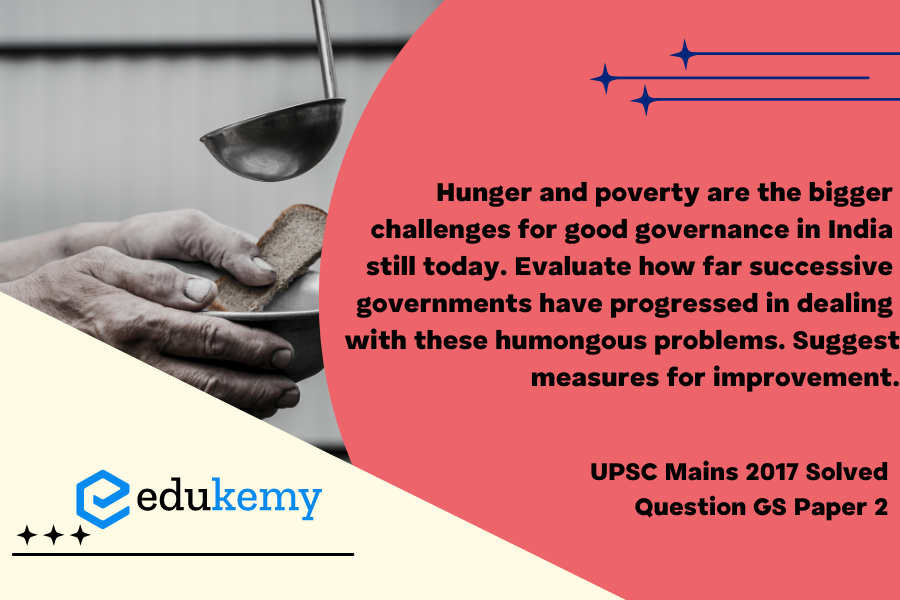Hunger and poverty persist as formidable challenges for effective governance in India, underscoring the urgent need for a comprehensive evaluation of the progress made by successive governments in addressing these pressing issues. Despite notable economic growth and developmental strides, a significant portion of the population continues to grapple with the harsh realities of insufficient food and impoverished living conditions. Evaluating the government’s efforts becomes imperative to gauge the effectiveness of existing policies and interventions. While some positive strides may have been taken, it is essential to identify the gaps and shortcomings that hinder the complete eradication of hunger and poverty. To enhance governance in this regard, measures such as targeted social welfare programs, improved agricultural policies, and enhanced employment opportunities must be advocated. A nuanced understanding of the challenges at hand is crucial for formulating policies that not only alleviate immediate suffering but also establish sustainable solutions for the future.
Tag: Social Issues; issues related to development.
Contents
Decoding the Question:
- In the Introduction, try to mention data/reports on the status of hunger and poverty.
- In Body,
- Discuss various government programmes related to it and mention their success.
- Mention some challenges and suggest measures to address issues.
- In Conclusion, mention the overall progress and suggest a way forward.
Answer:
According to the Global Hunger Index 2020, India ranks 94 out of 107 countries and has the highest prevalence of wasted children under five years in the world. Around 21.9% of the population lived below the national poverty line in 2011. From a famine-affected third-world country that depended on the import of food grains to feed its population to a food-secure nation, India has come a long way.
Progress and Achievements:
- Social Welfare Programs: Successive governments have introduced and expanded various social welfare programs aimed at alleviating poverty and providing food security. Programs like the Public Distribution System (PDS), Mahatma Gandhi National Rural Employment Guarantee Act (MGNREGA), and Pradhan Mantri Awaas Yojana (PMAY) have contributed to improving the living conditions of marginalized populations.
- Economic Growth: India has experienced significant economic growth over the years, which has led to increased job opportunities and improved living standards for many. This growth has lifted millions out of extreme poverty.
- Financial Inclusion: Initiatives to promote financial inclusion, such as Jan Dhan Yojana, have helped in providing access to banking services to a large number of previously unbanked individuals, enabling them to save and access credit.
- Nutrition Programs: Governments have also focused on improving nutrition through schemes like the Integrated Child Development Services (ICDS) and the National Nutrition Mission. These programs target the health and well-being of women and children, who are particularly vulnerable to malnutrition.

Challenges and Areas of Improvement:
- Inequitable Distribution: Despite economic growth, the benefits have not been evenly distributed. There is still a significant wealth gap, and poverty remains concentrated in rural areas and among marginalized communities.
- Weak Implementation: Many welfare programs face challenges related to leakages, corruption, and ineffective implementation. This hampers the intended impact of these programs on poverty and hunger.
- Lack of Quality Education: Education is a crucial tool for poverty reduction. However, the quality of education in many areas remains poor, leading to limited skill development and fewer opportunities for upward mobility.
- Underemployment: While job opportunities have increased, underemployment and low wages persist, especially in the informal sector. This affects people’s ability to escape poverty.
- Healthcare Access: Access to quality healthcare is still a concern for many impoverished individuals. High medical expenses can push families into further poverty.
- Urban Poverty: With rapid urbanization, urban poverty has become a pressing issue. Slums lack basic amenities, and informal settlements face challenges in accessing government services.
Measures for Improvement:
- Targeted Interventions: Develop targeted approaches to address the specific needs of different segments of the population, such as women, children, the elderly, and marginalized communities.
- Enhanced Implementation: Improve the implementation of welfare programs through the use of technology, transparent distribution systems, and robust monitoring mechanisms.
- Skill Development: Invest in skill development programs to equip individuals with market-relevant skills, enhancing their employability and income-generating potential.
- Health and Education: Strengthen healthcare and education systems, ensuring that quality services are accessible to all, particularly in remote and underserved areas.
- Employment Opportunities: Encourage job creation through both traditional and emerging sectors. Promote entrepreneurship and support small and medium-sized enterprises.
- Sustainable Agriculture: Promote sustainable farming practices to enhance food security, particularly in the face of climate change.
- Social Safety Nets: Strengthen and expand social safety net programs to provide a basic level of support to vulnerable populations.
The Indian government accords high priority to the issue of hunger and poverty and is implementing several schemes to improve food and employment situations in the country. India can certainly do better, with the right public policies focusing on agriculture, improved sanitation, women’s education, etc. to address these humongous problems and achieve sustainable development goals.
In case you still have your doubts, contact us on 9811333901.
For UPSC Prelims Resources, Click here
For Daily Updates and Study Material:
Join our Telegram Channel – Edukemy for IAS
- 1. Learn through Videos – here
- 2. Be Exam Ready by Practicing Daily MCQs – here
- 3. Daily Newsletter – Get all your Current Affairs Covered – here
- 4. Mains Answer Writing Practice – here


